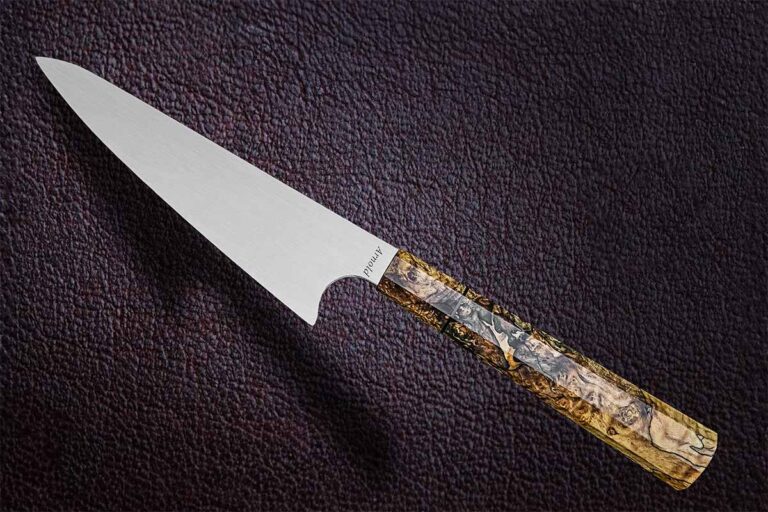
Larger than a paring knife, smaller than a chef’s knife, the petty knife is right-sized for heavy-duty precision work.
Sometimes food preparation calls for something especially suited for close, even intricate, work. The petty knife was made for such employment.
While it may be a bit smaller in stature than other knives chefs regularly use, the petty knife makes short work of otherwise laborious functions.
Its name is derived from the French petit or small, but it’s big on getting the job done.
“Ask a dozen makers what the petty knife is and you’ll get a dozen different answers,” offered custom maker Ian Ronald of Elderslie, New South Wales, Australia. “But for me, I would define a petty knife as a culinary knife that is shorter than a chef’s knife but with a broader blade than a paring knife. I find a petty knife to be incredibly handy for household food preparation tasks, with a blade that is big enough to cut most food items but not so large as a full-sized chef’s knife, making it a little more versatile for ‘in hand’ food prep tasks such as cutting avocados and similar things. I have a few in my kitchen and they are the most commonly used knives in the knife block by far.”
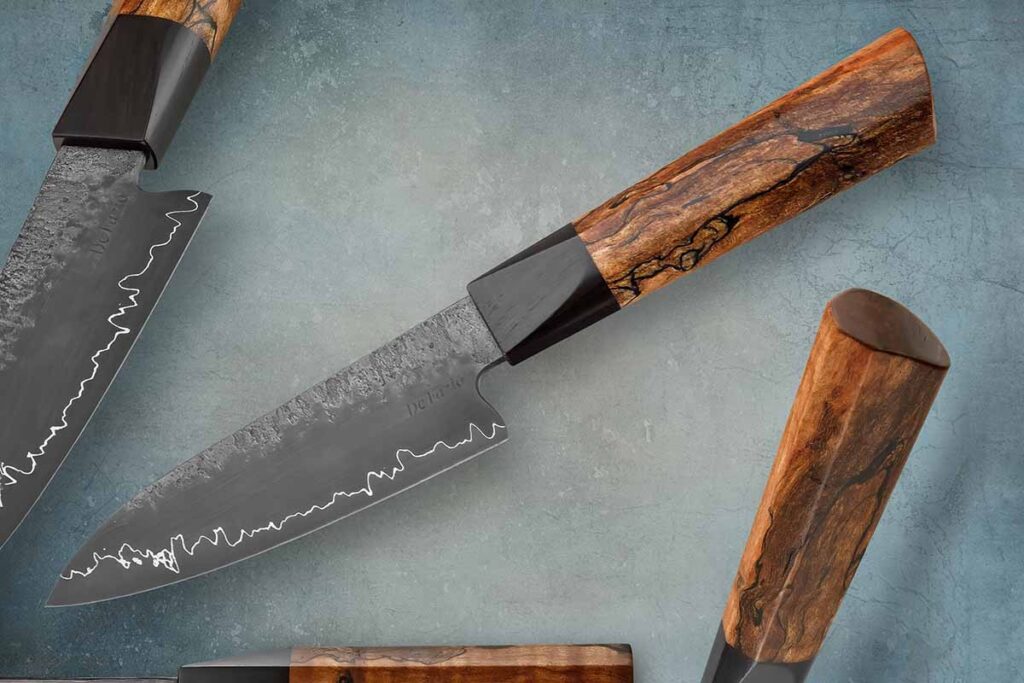
Representative of Ronald’s petty knife work is a piece the price of which varies depending on materials chosen. With a 4.92-inch blade of Takefu Special stainless clad in san-mai fashion over V-Toku2 carbon steel, a desert ironwood handle and 9.25-inch overall length, the petty remains with the maker—and he uses it frequently.
“I designed this knife with quite clean lines and simple shapes, as it was intended to be a workhorse from the beginning,” Ian commented. “I used some premium materials but I didn’t add any embellishments or unnecessary details. I follow that aesthetic with most of the knives I make, preferring to let the form follow the function for the most part. This particular knife has a relatively deep blade with a reasonably high tip profile, which allows it to be used for [rocking/chopping] and push cuts despite its unassuming size.”
The steel combination on Ronald’s knife includes a carbon core with stainless cladding from the Takefu steel company of Japan. According to Ian, it is quite corrosion resistant and maintains a bright appearance, as the carbon steel core etches dark and develops character and patina with use. The blade grind is nearly flat with a slight convex slant near the edge, which is intended to create a fine cutting edge while maintaining toughness.
Precision Worker Petties
Sixty-year-old Australian Zohar Oshinsky has been making knives since he was 12 but became more serious about his work just a few years ago, becoming a full-time maker in the past five years. His petty knife features a 5.12-inch blade of M390 stainless damascus steel from Sanwa Special Steel of Japan, handle scales of stabilized red mallee burl timber—a hardwood from the York peninsula of South Australia—and an overall length of 10.04 inches.
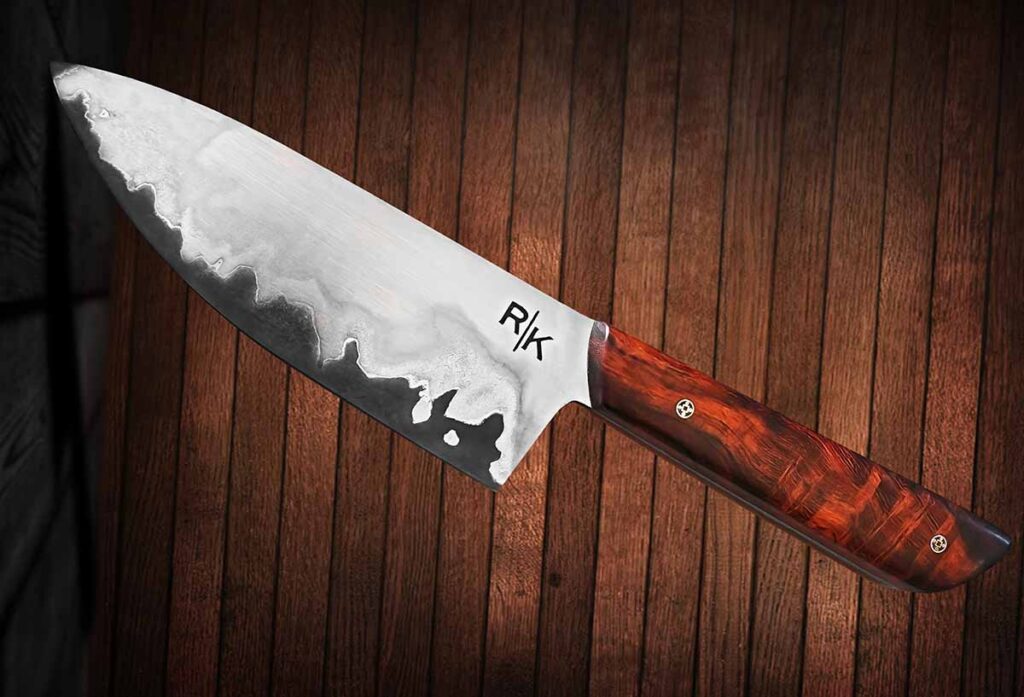
“This petty knife is a smaller Japanese utility knife,” Zohar said, “generally used for precision knife work and fine slicing. My knives are often made to order, so the material is to the customer’s liking. The san-mai is an excellent steel for kitchen knives in this construction with a very high rust resistance and excellent edge retention. The damascus cladding is made from 67 layers of 410 and high nickel stainless.”
Oshinsky says his blade grind is shallow, convex, very thin and incredibly sharp. The blade’s soft cladding protects the core from shock and provides a small amount of flexibility.
Semi-Dark Theme Petty Knives
Aidan De Fazio is all of 18. He began his knifemaking journey at 11 and his progress has been steady. His petty knife includes a 4.5-inch, full-flat-ground blade of san-mai in 1084 clad carbon steel with nickel. The handle is stabilized spalted maple and ebony. The blade is slightly convex ground to preserve edge longevity and provide better food release. Overall length: 9 inches.
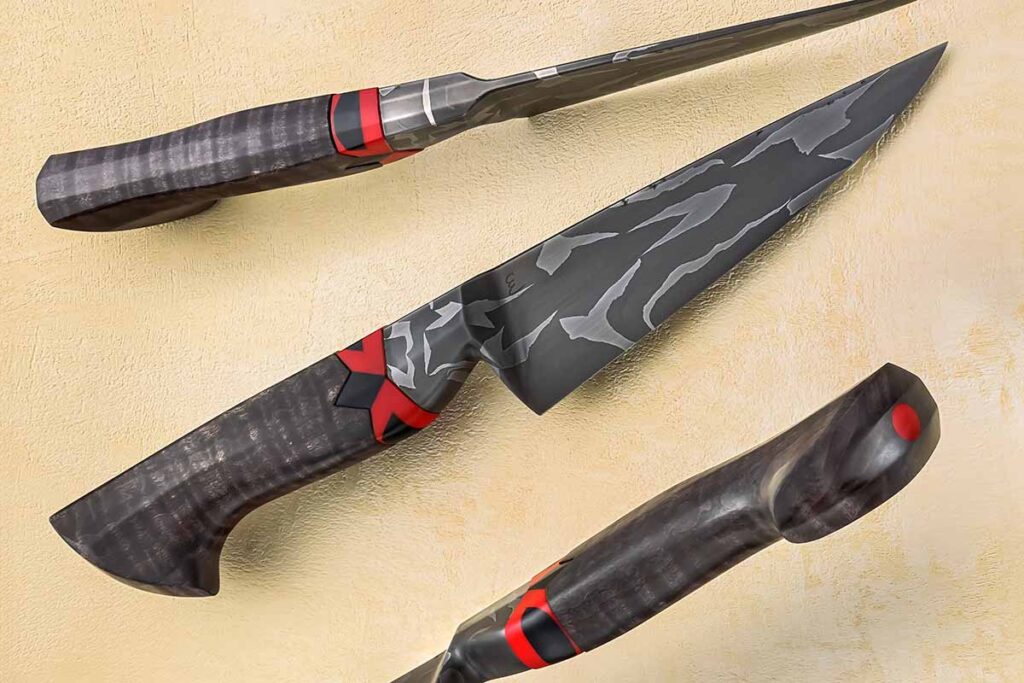
“The petty knife is a small general-purpose knife,” Aidan explained. “It’s used for peeling, shaping, and slicing fruits and vegetables, chopping herbs, and making garnishes. I design everything by eye and chose this design because everything flowed nicely, and it just looked right. I was going for a semi-dark-themed knife, so to complement the dark san-mai I chose a piece of ebony with some heavily spalted maple for the handle.
“As this is a carbon steel knife, it will change color with use,” Aidan continued. “It’s a patina and it’s a good thing. It develops on carbon steel when exposed to air for extended periods of time or to acids for short periods of time. It is a type of oxidation that helps ward off the rust that eats away at steel and destroys your knife.”
De Fazio recommends regular care for his petty knife, washing lightly with soap and water, avoiding abrasives that could scratch the patina, and then wiping dry for storage.
Light, Thin, Comfy Kitchen Tools
When Ross Arnold makes a petty knife—or any other style knife for kitchen use—he is leveraging experience to produce the most utilitarian design he can. “To me, a petty knife is an all-around food preparation knife for use when a larger knife is not necessary or possible,” he said. “In my earlier years, I worked in kitchens every night. I had a good idea of what worked and what was comfortable for me. This design was focused on being light, thin and comfortable. This resulted in a knife that weighs only 3.8 ounces, and the rounded choil and spine make it a pleasure to use all day every day.”
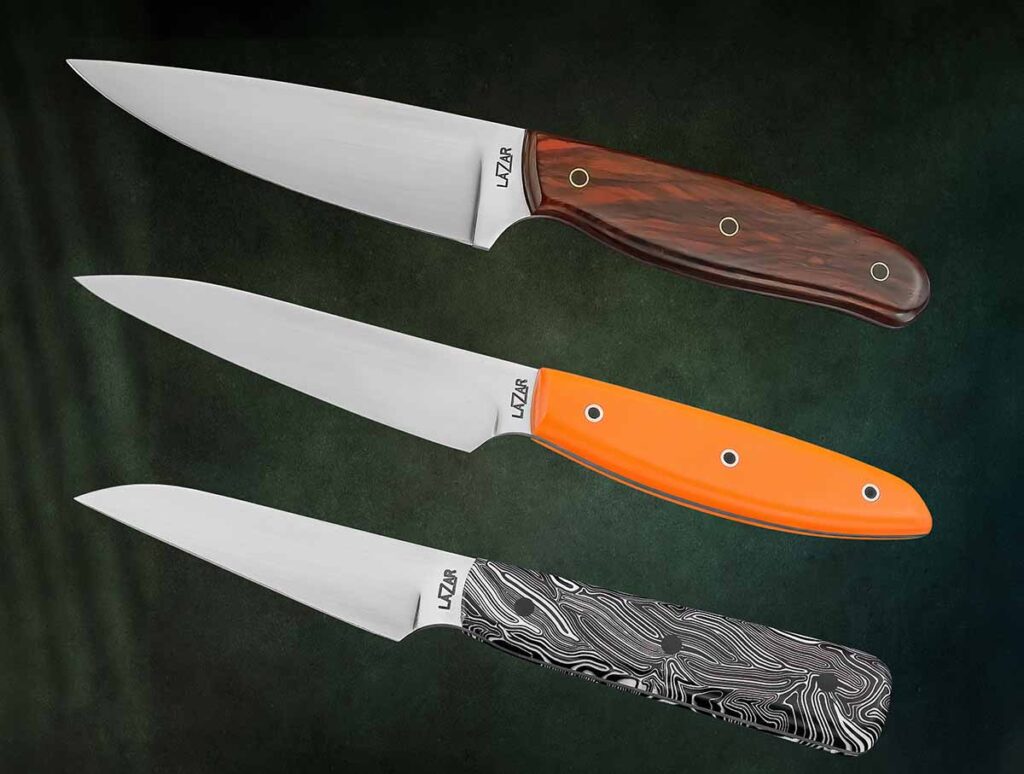
A resident of Glenalta, Australia, Arnold learned a great deal from custom maker Peter Bald early in his career. Ross finished his petty knife with a 5.91-inch blade of RWL-34 stainless steel and a handle of spalted sassafras wood. Overall length: 11.02 inches. His price for a similar knife: $390.
“I went with a traditional Japanese hexagonal handle purely for aesthetics,” he related. “As I use this knife primarily with a pinch grip, the handle shape does not have a massive impact on usability. That being said, it is still very comfortable to hold normally. I ground the blade with a plunge-less distal taper design. I came up with the grind design myself, but I’m sure it’s probably been done before. In my opinion, it is a solid performing grind as it gives the knife a light and flexible blade that isn’t super thick toward the tip.”
The petty knife is up to the challenge when a more intricate or tight kitchen job is at hand. The latest custom examples are affordable, provide good looks and perform with style. Dig in.
Editor’s note: All prices are in U.S. dollars and are according to the press time rate of exchange. Due to fluid market conditions, all are subject to change. Please check with the applicable maker for the latest in pricing.
Read More- Best Japanese Kitchen Knives Worth A Look
- BLADE 101: Types Of Kitchen Knives
- 5 Best Meat Cleaver Options
- 5 Best Santoku Knife Options
- 5 Best Serbian Chef’s Knives
- The Beauty Of Handmade Kitchen Knives
- Best Kitchen Knife Set To Upgrade Your Galley
 NEXT STEP: Download Your Free KNIFE GUIDE Issue of BLADE Magazine
NEXT STEP: Download Your Free KNIFE GUIDE Issue of BLADE Magazine
BLADE’s annual Knife Guide Issue features the newest knives and sharpeners, plus knife and axe reviews, knife sheaths, kit knives and a Knife Industry Directory.Get your FREE digital PDF instant download of the annual Knife Guide. No, really! We will email it to you right now when you subscribe to the BLADE email newsletter.






